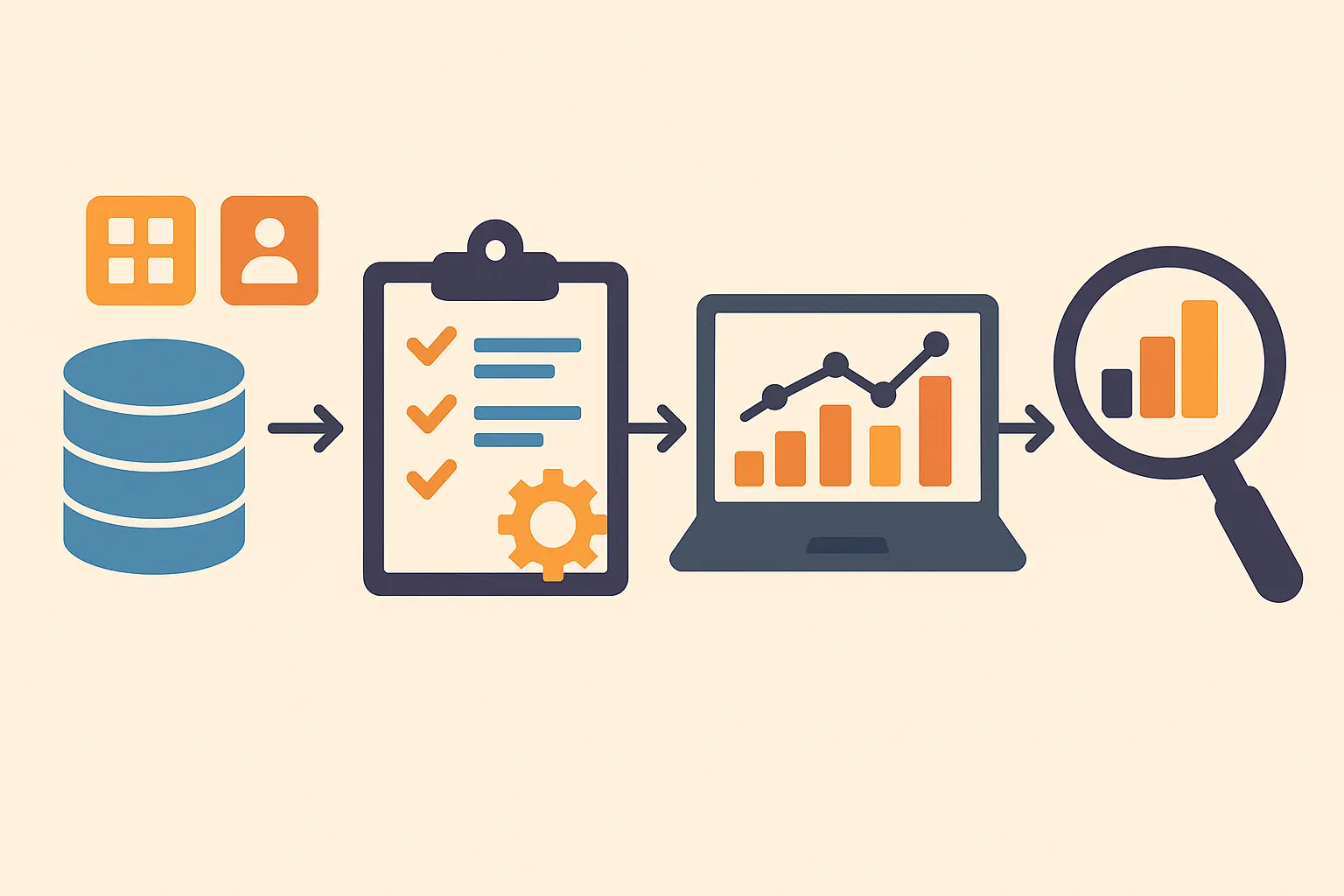The Real Deal About Salary Calculators (And Why You’re Probably Using Them Wrong)

Let me be honest with you – I used to think salary calculators were just fancy percentage machines. Punch in your current salary, add 10%, done. Boy, was I wrong.
After spending months testing these tools and watching people leave thousands on the table, I’ve learned that a modern salary increase calculator is actually pretty sophisticated. They’re not just doing basic math anymore – they’re crunching performance data, market trends, and geographic factors to give you real insights.
But here’s the kicker: most people are still using them like it’s 2010.
Table of Contents
- What These Tools Actually Do (Spoiler: It’s Not Just Math)
- The Different Types (And Which One You Actually Need)
- Advanced Features That Actually Matter
- How to Actually Use These Things
- Making It Work for Your Company
- Connecting Salary Goals to Real Career Success
TL;DR
- Modern salary calculators aren’t basic percentage tools – they analyze performance, market data, and location to give you real insights
- AI-powered systems can predict salary trends and provide recommendations based on your specific career path
- Success comes from proper data preparation and picking the right calculator for your situation
- Companies need clear policies and trained teams to implement these tools effectively
- The best approach combines smart calculations with strong career development and presentation skills
What These Tools Actually Do (Spoiler: It’s Not Just Math)
Forget everything you think you know about a salary increase calculator. The good ones aren’t just adding percentages – they’re analyzing your entire situation.
Take Sarah, a marketing manager making $60,000. Sure, a basic calculator would tell her that a 10% raise equals $66,000. But the advanced tools? They’re looking at her location (is she in expensive San Francisco or affordable Austin?), her performance metrics, and what other marketing managers are actually earning right now.
That’s the difference between getting a generic answer and getting actionable intel.
The math has gotten pretty sophisticated too. According to Omni Calculator’s pay raise tool, modern systems use formulas like “new salary = old salary + old salary × raise %” but layer in complex algorithms that factor in compound growth, cost-of-living adjustments, and performance weightings. We’re talking about calculations that actually reflect reality. This is why using a salary increase calculator is more reliable than guessing or relying on outdated formulas.
And here’s something that blew my mind: “SmartAsset’s 2025 salary study” found that people need about $5,844 more than last year just to maintain the same lifestyle. Hawaii residents need $124,467 for a single adult to live comfortably. If your calculator isn’t accounting for that, you’re already behind.
The government knows this stuff matters too. The “8th Pay Commission to roll out from Jan 2026 with a significant salary hike” according to Vajira Mandravi, shows how large organizations use structured approaches for millions of employees. They’re not guessing – they’re calculating.
The Numbers That Actually Matter
Modern calculators pull from data sources most people never consider. They’re looking at your performance metrics, sure, but also industry growth rates, regional economic indicators, and even your company’s financial health.
I helped a friend who works in pharmacy tech roles understand her real market value by looking at certified pharmacy tech salary trends. Generic calculators suggested a 5% bump for her certification, but specialized healthcare tools showed certified techs in her area were getting 12-15% increases. That’s real money.
Why Most People Get It Wrong
The biggest mistake? Treating these tools like magic 8-balls. People punch in their current salary, maybe select their job title, and expect meaningful results.
That’s like trying to navigate cross-country with a broken GPS. You might get somewhere, but it probably won’t be where you wanted to go.
Consider this scenario: You’re earning $60,000 and want to know about a raise. A basic calculation using Omni Calculator’s formula gives you $60,000 + ($60,000 × 0.10) = $66,000 for a 10% increase. But an advanced salary increase calculator factors in your geographic location, performance metrics, and current market conditions to tell you whether 10% is realistic, too low, or completely unrealistic.
The quality of your inputs determines the value of your outputs. Garbage in, garbage out – it’s that simple.
| Data Input Category | What It Actually Affects | Why It Matters |
|---|---|---|
| Current Compensation | Baseline for all calculations | Without accurate starting point, everything else is wrong |
| Performance Metrics | Merit-based adjustments | Top performers shouldn’t get average raises |
| Market Factors | Competitive positioning | Your value depends on what others are earning |
| Experience Level | Career progression expectations | Years of experience directly impact earning potential |
| Economic Indicators | Real purchasing power | Inflation can make a “raise” actually be a pay cut |
The Different Types (And Which One You Actually Need)
Not all calculators are created equal. I’ve tested dozens, and the quality range is wild. Here’s what you’ll find out there:
Basic Percentage Tools for Quick Reality Checks
These are your “training wheels” calculators. Good for quick estimates, terrible for serious negotiations. TimeTrex’s pay raise research shows that “a raise of 3-5% is considered standard” with exceptional performance potentially warranting higher percentages, but these basic tools won’t tell you if you deserve more.
They’re useful when you need rapid calculations for budget planning or initial discussions. Sometimes simple is better, especially for straightforward scenarios like standard annual reviews.
According to Omni Calculator’s research, “a 10% annual raise is the same as a 10% monthly, weekly, or hourly raise” when applied consistently, making these simple tools surprisingly versatile for basic calculations.
Market-Driven Calculators That Know What’s Happening
Now we’re talking. These pull real-time data from job markets and industry reports. They know that a software engineer in Seattle needs different compensation than one in Nashville.
These tools continuously update their databases with current compensation trends, so their suggestions reflect what’s actually happening in your industry and location. They’re invaluable for competitive positioning and market-based negotiations.
I prefer these when helping someone prepare for a major salary discussion because they give you data-backed arguments instead of wishful thinking.
Healthcare professionals looking to calculate increases often need industry-specific insights. Those reviewing PA salary insights understand how their earnings potential compares within the medical field and can input industry-specific benchmarks into their calculations.
Performance-Based Systems That Reward Results
My personal favorites for high performers. These factor in your actual results – goal achievement, KPIs, contribution levels. If you exceeded your sales quota by 150%, why should you get the same raise as someone who barely hit theirs?
These systems create personalized recommendations based on real impact. They’re particularly valuable for organizations with strong performance cultures where top performers expect different treatment.
Here’s how it works: A sales rep who exceeded quota by 150% might get a performance multiplier of 1.5x applied to their base raise percentage. If the standard raise is 4%, their performance-adjusted increase becomes 6% (4% × 1.5), reflecting their exceptional contribution.
AI-Powered Systems That Predict Your Future
The fancy stuff. These analyze your career trajectory, predict market trends, and give personalized recommendations. Some are getting scary accurate at predicting where salaries are headed.
I’ve been testing some that correctly predicted a friend’s marketing role would see a 15% bump when she switched from retail to tech – six months before she made the move. Machine learning algorithms learn from thousands of career paths to improve accuracy over time.
They’re particularly useful for long-term career planning because they can forecast future earning potential based on current market trajectories.
Inflation-Adjusted Tools for Real Money
These account for cost-of-living changes and inflation rates to maintain actual purchasing power. Without considering inflation, you might think you’re getting ahead when you’re actually falling behind.
Research from Omni Calculator’s salary analysis indicates that “emotional well-being correlates with salary only up to a salary of $75,000 annually,” making inflation adjustments particularly important for maintaining quality of life within this critical income threshold.
Advanced Features That Actually Matter
The fancy features are where things get interesting. Modern calculators aren’t just crunching numbers – they’re using AI to understand your career path.
AI That Actually Gets Your Career
I’ve been testing some AI-powered tools that analyze thousands of career trajectories to predict where your salary should be heading. It’s honestly a bit creepy how accurate they’re getting.
These systems learn from historical salary data and successful compensation decisions to improve recommendations over time. Predictive modeling helps forecast future salary trends for informed long-term planning.
The AI doesn’t just look at your current role – it analyzes your skills, experience progression, and market demand to predict your earning potential across different career paths.
Real-Time Market Integration That Actually Works
The best calculators pull fresh data constantly. Government labor stats, industry surveys, job posting analytics – they’re monitoring it all. This matters because salary trends can shift fast. What was accurate six months ago might be completely off today.
Here’s a breakdown of data sources and how they actually impact your calculations:
| Market Data Source | Update Frequency | Accuracy Level | What It’s Actually Good For |
|---|---|---|---|
| Government Labor Statistics | Every 3 months | High | Solid baseline comparisons |
| Industry Salary Surveys | Once a year | Very High | Role-specific benchmarks |
| Job Posting Analytics | Real-time | Moderate | Current market pulse |
| Company Compensation Data | Varies wildly | High | Internal fairness checks |
| Economic Indicators | Monthly | High | Cost-of-living reality checks |
Customization That Matches Your Reality
Generic advice is worthless advice. The tools worth using let you input your specific situation – your exact role, responsibilities, skills, even your company’s financial health.
Role-specific parameters allow you to input job-specific details including responsibilities, required skills, and career level to receive tailored recommendations that align with your actual situation rather than generic industry averages.
Financial sector professionals preparing for advancement often combine salary calculations with targeted preparation. They review banking interview questions to ensure they can effectively communicate their value during compensation discussions.
How to Actually Use These Things
Here’s where most people mess up – they treat calculators like magic 8-balls. Shake, get an answer, done. Wrong approach.
Get Your Data Together First
Before you touch any calculator, gather your ammunition. Comprehensive data preparation forms the foundation of accurate calculations.
Your Data Collection Checklist:
- Complete compensation breakdown (base, bonuses, benefits – not just your base salary)
- Performance metrics from the last 2-3 years
- Industry salary survey data for your role
- Geographic cost-of-living information
- Company financial performance indicators
- Professional development and certification records
- Market demand indicators for your skills
This preparation work directly impacts the quality of recommendations you’ll receive. Spend time here – it pays dividends later.
Pick the Right Tool for Your Situation
Match the salary increase calculator to your needs. Standard annual review? Basic tool might work. Major promotion or job change? Go advanced.
Selecting the appropriate calculator type based on your specific circumstances and configuring it with accurate parameters determines how useful your results will be. The wrong calculator will give you wrong answers, no matter how good your data is.
Current workplace trends show the importance of strategic planning. “ADP’s compensation insights” notes that “Workers can often be overly optimistic about pay increases. Employers are balancing tight budgets with these expectations and efforts to retain, reward and motivate their people.”
Don’t Trust One Source
Run multiple calculations. Compare against independent research. The goal isn’t to find the highest number – it’s to find the most realistic one.
Understanding calculator outputs requires careful analysis of recommendations and consideration of multiple factors beyond the suggested numbers. Compare results against independent market research, consider timing and organizational constraints, and prepare negotiation strategies based on insights.
When analyzing calculator results showing a recommended 12% increase, compare this against industry standards (typically 3-5% annually), your performance metrics (above-average performers might justify 8-10%), and company financial health (profitable companies can afford higher increases) to determine if the recommendation is realistic and achievable.
The numbers are just the starting point for informed salary discussions, not the final word.
When presenting calculated increases to employers, having a professional resume format that clearly demonstrates your achievements and market value strengthens your negotiation position and supports your compensation requests.
Making It Work for Your Company
If you’re on the employer side, listen up. Rolling out salary calculators without proper policies is like giving everyone a Ferrari without teaching them to drive.
Build Policies That Make Sense
You need clear rules about who can use what calculators and when. Otherwise, you’ll have chaos. Successful organizational implementation requires clear policies governing how calculators will be used in salary decisions and what factors will be prioritized.
Your Implementation Framework:
- Define calculator usage scenarios and decision authority
- Establish data quality standards and validation processes
- Create approval workflows for different increase levels
- Set budget constraints and financial parameters
- Develop communication protocols for salary decisions
- Implement regular policy review and update cycles
These guidelines ensure consistent application across departments and provide transparency for employees about how compensation decisions are made.
Train Your People Properly
Your HR team needs to understand both the technical side and the strategic implications. Ensuring HR teams and managers understand how to properly use calculators and interpret results is crucial for fair compensation decisions.
Effective training programs cover both technical usage and strategic interpretation to help teams make informed decisions that align with organizational goals and employee expectations. Poor training leads to poor decisions, which leads to unhappy employees.
Keep Your Calculations Accurate
Validate your results regularly. Cross-reference with independent surveys. Track whether your calculator recommendations correlate with actual retention and performance rates.
Regular validation ensures calculator recommendations remain accurate and aligned with organizational goals and market realities. This involves cross-referencing results with independent salary surveys and analyzing whether recommendations correlate with actual performance outcomes and employee retention.
If your “accurate” tool is giving you bad advice, fix it or ditch it. Accuracy matters more than convenience when it comes to compensation decisions.
Connecting Salary Goals to Real Career Success
Here’s where most people drop the ball. They calculate their dream salary, then do nothing to actually achieve it.
Your target number is meaningless without a plan to get there. Understanding salary increase calculations becomes more powerful when combined with comprehensive career development strategies. While calculators help you determine target compensation, achieving those goals requires professional presentation skills and strategic career positioning.
I’ve seen people calculate perfect salary targets, then present them with outdate d resumes that don’t reflect their current value. It’s like bringing a calculator to a gunfight.
Resume Builder IQ recognizes this connection and provides AI-powered tools that help professionals optimize their resumes with job-specific keywords and ATS-friendly formatting, directly supporting the salary increase process.
When you’ve calculated your target salary increase, having a resume that effectively communicates your value becomes crucial for negotiating that increase or securing a new position at the desired compensation level. Resume Builder IQ’s templates and AI-driven content suggestions help you articulate achievements and skills that justify higher compensation, while their market insights ensure your resume reflects current industry standards that align with salary expectations.
The government’s 8th Pay Commission rollout in 2026 shows how systematic organizations approach compensation. They don’t just pick numbers – they analyze performance, market conditions, and long-term sustainability.
That’s the approach you need for your own career.
Ready to turn your salary calculations into actual results? Try Resume Builder IQ’s AI-powered resume optimization to create professional presentations that support your compensation goals.
What Actually Works (My Final Take)
After testing dozens of these tools and helping people navigate salary negotiations, here’s what I’ve learned:
Salary calculators are powerful when used correctly. They give you data-backed targets instead of wishful thinking. But they’re just the starting point.
The real work happens after you run the calculations. That’s when you need to build the case, update your professional materials, and have the difficult conversations.
A salary increase calculator has evolved from being a simple percentage tool into a sophisticated career planning resource that can genuinely impact your compensation trajectory. The key lies in understanding which type of calculator matches your needs, preparing comprehensive data, and interpreting results within the context of your specific situation and market conditions.
Don’t treat these tools like fortune tellers. Treat them like research assistants that help you make informed decisions about your career.
The best calculator in the world won’t help if you can’t articulate why you’re worth the increase. But combine good calculations with strong presentation skills and market awareness? That’s how you actually move the needle on your compensation.
Remember that these tools are most powerful when combined with strategic career development efforts. Your calculated salary targets mean nothing without the professional presentation skills and market positioning to achieve them. Success comes from treating salary calculations as one component of a comprehensive career advancement strategy rather than a standalone solution.
Your salary targets need to be grounded in reality and supported by evidence. These calculators help with both, but only if you use them strategically rather than desperately.











